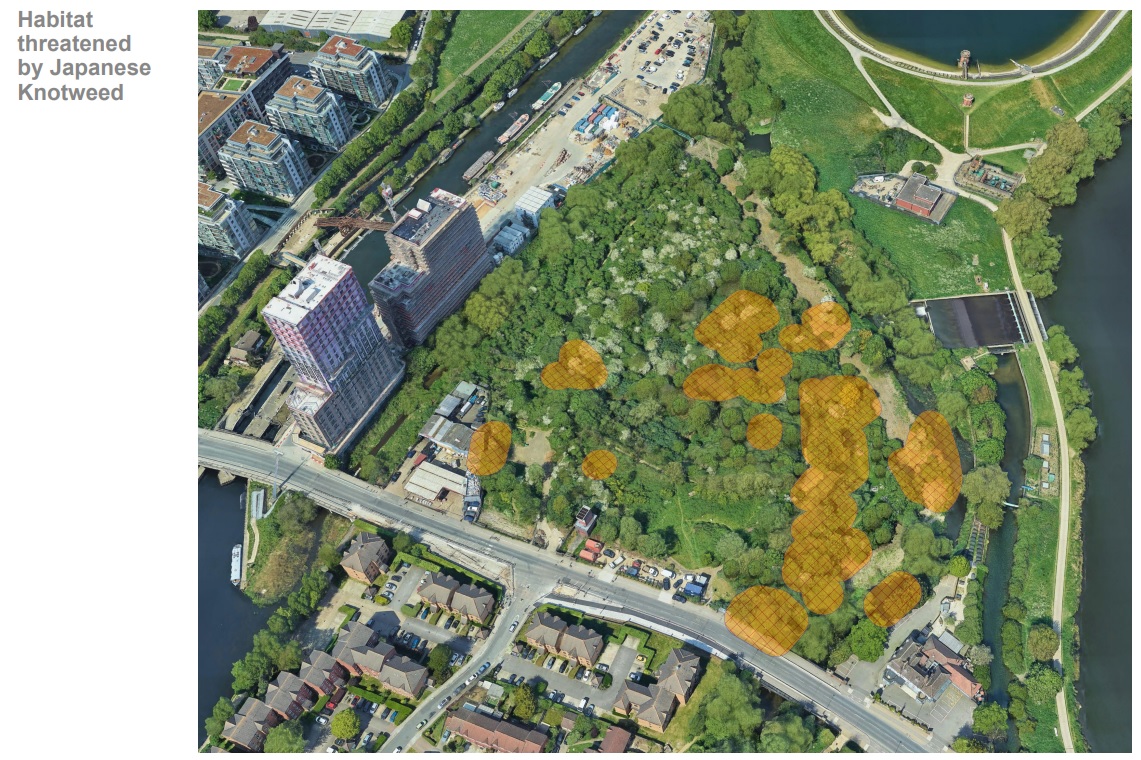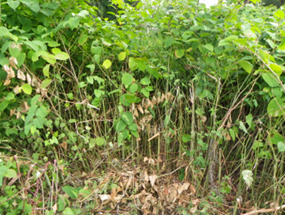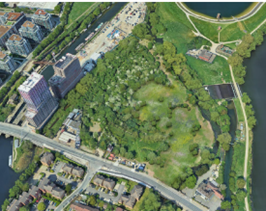Home
Japanese Knotweed treatment
Japanese Knotweed at The Paddock
Damage to the ecosystem
The ecology and biodiversity of the Paddock is threatened by several infestations of Japanese Knotweed, an invasive plant that can dominate habitats and is difficult to control. It affects ecosystems by crowding out native vegetation and limiting plant and animal species diversity.
Eventually, without treatment the Japanese Knotweed will spread throughout the site and outcompete existing vegetation and the unique ecologies currently present, leading to large areas of bare ground as illustrated in the image below. In turn this will reduce the biodiversity of The Paddock as food sources as habitats disappear.

The spread of Japanese Knotweed
Over the last 3 years there have been noticeable increases in Japanese Knotweed spread within The Paddock. This is creeping towards the locally rare wet woodland that contains unique mosses and lichens together with historical hiberaculas, in the northern corner of the site.
What is Japanese Knotweed?
Japanese Knotweed (Fallopia japonica) is native to Japan, Taiwan and northern China, and was introduced to the UK in the early 19th century as an ornamental plant. It is a perennial plant, growing each year from its extensive underground rhizomes, and spreads rapidly both by natural means and as a result of human activity.
Japanese Knotweed is spread by fragments of rhizome (root system) or stem being transported to new sites. Very small fragments of stem/rhizome can give rise to new plants. The plant forms dense stands, outcompeting our native vegetation and causing structural damage.
Legal Obligations
As landowners, Haringey Council has a responsibility to control the spread of Japanese Knotweed. Japanese Knotweed is listed in Schedule 9 of the Wildlife and Countryside Act 1981 and is subject to Section 14 of this Act. It is an offence to plant or cause this species to grow in the wild. As The Paddock evolves through the Paddock Enhancement Project and receives more visitors, the chances of the Japanese Knotweed being spread will only increase. Therefore, effective and long-lasting control is the responsibility of Haringey Council.
Dealing with Japanese Knotweed at The Paddock
Evidence Background
Extensive site-wide investigations were carried out within The Paddock in 2019 to assess the impact of the Japanese Knotweed, which made the following conclusions:
- The raised ground within The Paddock is contaminated with asbestos fibres that are cost prohibitive to remove and represent a hazard to human health if disturbed
- A large volume of the Japanese Knotweed has established rhizomes (root systems) within the asbestos fibres, thus complicating treatment options
- Further investigation revealed that patches of Japanese Knotweed were showing resistance to chemical treatment (bonzai growth)
- Isolated outcrops of Japanese Knotweed were further identified within the site.

Stunted bonzai growth

An isolated outcrop of Japanese Knotweed
A bespoke treatment package
The Japanese Knotweed infestations that threaten the biodiversity and habitats of The Paddock will be cleared in a comprehensive site remediation scheme. A specialist 'cell-burial' technique will be used to ensure effective, long-lasting control of this fast-spreading invasive species, coupled with selective spraying.
Excavating and securely burying the Japanese Knotweed
A pit will be created on site to bury all uncontaminated Japanese Knotweed and cap it with soil. Removing large quantities of Japanese Knotweed off site is both cost -prohibitive and damaging to the environment in terms of vehicle emissions and the potential spread of Japanese Knotweed.
Large-scale machinery will be employed to complete the works on site as soon as possible, meaning more efficient operations in terms of time and less emissions as fewer vehicle movements will be needed.
The capping works will mean the clearance of scrub and groups of trees of various sizes and quality in affected areas. Approximately 80 trees will be planted on site in the through the main landscaping works, including the nationally rare Black Poplar (Populus nigra), of which there are only about 7000 wild specimens in Britain. The remainder will be native species suited to The Paddock habitat.
The Japanese Knotweed will be wrapped in a secure geotextile membrane to complete the capping works and ensure long-term remediation. The membrane has a 50-year service life with a 25-year guarantee. Locally-sourced and certified soil will then be used to create a 2 metre cap over the burial cell, presenting a unique opportunity to develop a habitat from scratch - in this case a nationally rare wildflower meadow.
Selective spraying
While the objective from the start has been to minimise the use of chemical treatments, in certain areas of the site excavation of Japanese Knotweed would mean damage to the surrounding habitat that would outweigh the benefit of mechanical removal. Therefore, a spraying programme will be implemented in such areas. These areas will be fenced off and have clear information boards displayed.

Infestations of Japanese Knotweed prior to works

The Paddock habitat after Japanese Knotweed works
Biosecurity measures
Even a tiny fragment of Japanese Knotweed rhizome can create a new infestation.
Haringey Council has worked closely with the specialist contractors to ensure that they are fully compliant with biosecurity responsibilities and duties which include:
- Decontamination of machinery and equipment, including the cleaning down of machinery following all works and removing any rhizome fragments
- Clearly marking out machinery and vehicle routes in order to prevent tracking over contaminated areas
- Checking Personal and Protective Equipment (PPE) such as work boots for rhizome fragments; and that full PPE is worn at all times, in line with health and safety frameworks
- Ensuring that machinery is never tracked into contaminated areas
- Taking soil samples carefully, ensuring all activities are conducted directly within the footprint of the Japanese Knotweed infestation area.
Future-proofing
- All the Japanese Knotweed work has extended guarantees and insurances
- The membrane has a 50-year guarantee
- There is a 10-year invasive species management programme on site
- There will be full-time site management.
After the works: a new meadow
Why a meadow?
Long-term decline
Meadows have seen a drastic decline in the UK: over 97% of wildflower meadows have been lost since the 1930s, much of which can be attributed to the intensification of agriculture after WWII (Fuller, 1978).
Today, species-rich grassland now only covers a mere 1% of the UK’s land area. All that remain are just 26,000 acres (10,500 hectares) of lowland wildflower meadow and 2,223 acres (900 hectares) of upland hay meadow in the UK (Plantlife).
The charity Plantlife’s botanical specialist, Dr Trevor Dines, was quoted as saying: "The steady, quiet, and under-reported decline of our meadows is one of the biggest tragedies in the history of UK nature conservation.”
Species diversity
These habitats support a vast number of flower and grass species, with studies showing they could contain up to 30 species of plants per square metre (Smith 2010).
This is turn supports a myriad of insects including bees, butterflies, beetles and grasshoppers. A healthy insect population also supports species higher up the food chain such as birds and mammals.
But with the decline in meadow habitat grassland flowers which were once common have declined and are on the ‘Near Threatened’ list in England. These include: quaking-grass, harebell, wild strawberry, common rockrose, field scabious, hoary plantain, ragged robin and devil's bit scabious (Plantlife).
A 2019 study revealed losses to a staggering one third of wild pollinators surveyed in the UK over the past three decades (Gary D. Powney et al 2019).

Wildflower meadows established by TCV at Russia Dock Woodland in 2018
Aesthetic value
As well as the considerable ecological value, there is a notable aesthetic value of these spaces. Bright colours, the humming sounds of insects and the gentle movement of grasses throughout the Spring and Summer can be an attractive and popular addition to community greenspaces like The Paddock.

Slope at Brockwell Park SE24 in 2013
Comparisons with Woodland
Research from Plantlife indicates that wildflower meadows are botanically richer than any other habitat in this country. They are home to nearly half our flora but occupy less than 1% of the UK’s land cover.
'Early succession’ habitats require sufficient levels of management to keep them viable. The research reveals that 611 plant species of 1,543 analysed (40%) will decline within a decade if the land is entirely abandoned, with 127 of these (16.4%) declining within three years. Three quarters of our most threatened species - including burnt-tip orchid, pasqueflower and crested cow-wheat - decline or disappear within three years if all management is removed.